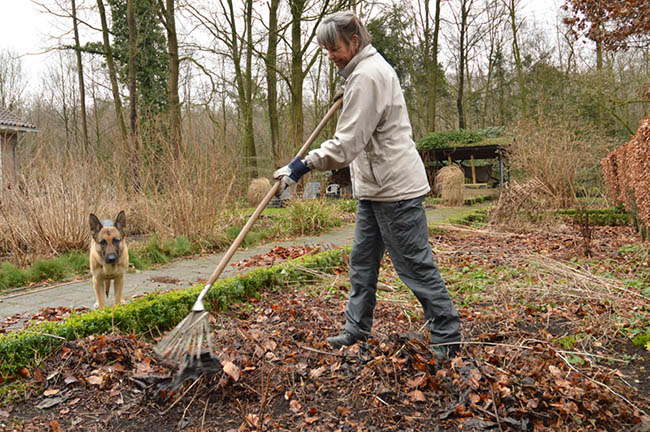Stinzenbulbs and bulbs suitable for naturalising are very robust and in most cases multiply readily, even with little maintenance. However, a little bit of attention doesn’t go amiss. They’ll spread quicker and flower more. Some tips...

- Make sure that the bulbs don’t have too much competition from (evergreen) weeds.
- If in the autumn the stinzneplanten become covered with fallen leaves then remove 80% of the leaves, or use a leaf shredder. This prevents the bulbs from being smothered. The leaves can be added to the leaf heap (information about how to make your own leaf heap is given further down this page).
- Even if the ground was well cultivated and improved when the bulbs were first planted, it’s beneficial to spread 1-2cm organic matter (leafmould from your own leaf heap is best!) from the second year onwards, every winter. Lime can be added to the mix if you have a sandy soil.
- Using fertiliser is good, but in moderation! Use only a quarter of the recommended dosage (usually listed on the package). Use an ‘autumn’ fertiliser also in the spring. This is high in phosphorus and potassium, and these ingredients are beneficial to flowering bulbs.
- Some evergreen ferns (which after a frosty period look a bit bedraggled) are best cut down in February so that they don’t smother spring-flowering bulbs.
- Clump-forming stinzenbulbs (such as the Snowdrop), can be dug up, divided and replanted every three to four years. The best time of year to do this is in May; the plant is nearly in its dormant period, but the foliage of the plant is still visible.
- Are the bulbs growing in a meadow (a stinzen-meadow) or lawn? Start mowing after the bulbs have set seed and have died back. Depending on the bulb, this will either be in May, June or July.
How do I make a leaf heap? If you haven’t already got an own compost or leaf heap, then it’s well worth making one! They’re pretty easy to make. To make leafmould mound the leaves into a heap and, now and again, add a handful of lime. Leave the leaf heap to mature for at least 1 year (2 years is ideal). Nature does its work, and voila, you have beautiful leafmould! Apply the same steps to make a compost heap. Remember not to throw any weeds with seed heads on the compost heap, or any perennial weed roots (these can resprout when the compost is used in the garden and cause unnecessary weeding-work).
The most often asked question regarding leaf heaps is: can I throw all sorts of leaves on the heap? And the answer is, yes! However, the rate of rotting depends on the leaf sort. Oak leaves (especially from the Red oak) take the longest to rot down to leafmould.
Peat is a precious and finite resource and therefore we strongly advise against its use.
Compost is often available via green recycling businesses, councils and in bags at the garden centre. This compost may be cheap, but is also sharp and ‘dead’ – it contains few micro-organisms in comparison to home-made leafmould and compost. And micro-organisms (bacteria and fungi) are essential to the growth of bulbs. If used, bought compost is therefore best mixed with home-made leafmould or compost, and shouldn’t make up more than 50% of the mix.
